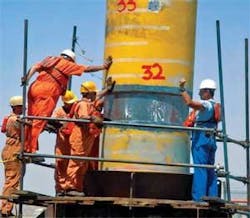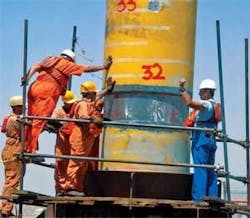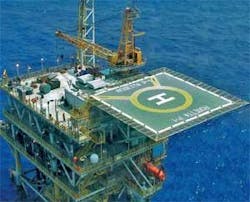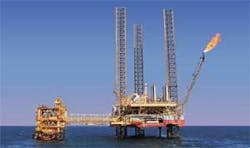Egypt’s Petroleum Future: Adding value to natural gas, developing deepwater prospects are key goals
Egypt began the ascent to its position as a leading global energy player by leveraging its strategic location. Building the Suez Mediterranean (Sumed) pipeline to augment the Suez Canal, the country put together a critical transportation infrastructure that linked large oil reserves to world markets.
It was an auspicious beginning. But it was only the first step towards optimizing the value of Egypt’s own petroleum resources. Next, a long-term strategy was developed to accelerate reserves and production growth, and to expand the capabilities of Egyptian companies to drive that growth well into the future.
An important goal of that strategy is to realize the full potential of Egypt’s natural gas resource, much of which lies in the deep water of the Mediterranean. In addition, a master plan will help wring the most value from that resource by expanding petrochemical, liquefied petroleum gas (LPG) and liquefied natural gas (LNG) capacity to serve domestic demand and capitalize on export markets.
Together, its history and its energy strategy promise a bright future for Egypt’s petroleum industry. To help reach that future, the country offers:
- Tempting oil and gas prospects;
- Political, financial and legal stability;
- Established international relationships;
- A skilled, educated, enthusiastic workforce;
- Keen environmental responsibility.
Deep water and gas
Along with its other natural and human resources and its physical assets, natural gasespecially that which lies in deep wateris critical to Egypt’s energy future.
As of June 30, 2007, Egyptian Natural Gas Holding Co. (EGAS) estimated Egypt’s gas reserves at 72.3 trillion cubic feet (tcf). An estimated 78% of this resource is in the Mediterranean, 4% in the Nile Delta onshore, 10% in the Western Desert area and 8% in the Gulf of Suez.
Yet-to-find reserves may total as much as 120 tcf, according to EGAS.
Other reports are even more optimistic. One estimate puts ultimate reserves in the ultra-deep water alone at 70 tcf. Another report puts total reserves at 128 tcf, including 80 tcf in the Mediterranean deep water and 28 tcf in shallow water; 9 tcf in the Nile Delta onshore; and 11 tcf in the Western Desert.
Badr El-Din
Formed to develop and explore for oil and associated gas in Egypt’s Western Desert, Badr El-Din Petroleum Co. (Bapetco)a 50- 50 joint venture between Shell Egypt N.V. and Egyptian General Petroleum Corp. (EGPC)has played a significant role in the launch of Egypt’s growing gas industry. Currently one of the country’s largest gas producers, Bapetco was established in 1983 after the Badr El-Din (BED) field in the Western Desert about 130 km (81 miles) southwest of Alexandria was declared commercial. Now the company operates in other areas of the Western Desert on behalf of EGPC and Shell Egypt.
Bapetco’s in-place gas reserves were 2,935 billion cu ft (bcf) at the beginning of fiscal 2007; ultimate recoverable reserves were estimated at 1,882 bcf. Bulk of the company’s 220 bcf of remaining reserve is in three fields in the Badr El-Din concessionBED-2 (88 bcf), BED-3 (72 bcf) and BED-15 (43 bcf).
Its first gas sales, from the BED-3 field, were in 1990; in 1999, it delivered first gas from the Obaiyed field to the Obaiyed gas plant. Bapetco gas production during fiscal 2005-2006 averaged 223 MMcfd.
Bapetco also held about 121 million bbl of recoverable oil reserves and 40 million bbl of recoverable condensate at the end of last fiscal year.
With a focus on exploration, spending during 2005/2006 fiscal year was US$171 million, including exploration cost of about US$28 million and development expense of US$89 million. Operating cost was US$25 million.
HSE performance
The record tells the story of Bapetco’s intense, continuous focus on improving health, safety, and environmental (HSE) performance. After its formation in 1983, the company achieved 3 million man hours without a lost time incident (LTI) in 1993; 5 million man hours without LTI for staff and contractors in 1998; and 12 million LTI-free man hours for Bapetco and contractors in 2000.
There were no fatalities during last fiscal year, and staff achieved 2.6 million hours free of a lost time incident on 31st of January 2006. Labouring in the oil and gas sector. Rashpetco’s P1 unmanned platform, Rosetta. Other metrics also highlight Bapetco’s HSE performance:
- The BED area project team reached six years without an LTI in August 2005;
- In April 2006, Al Hamra area completed 19 years free of LTIs, and;
- In December 2005, Al Amereya achieved 15 LTI-free years.
The corporate HSE plan issued in February 2006 achieved more than 40% of its objectives by June, meeting its target.
Bapetco’s HSE policy includes a biodiversity standard and road transport safety guidelines; it also covers issues of smoking and alcohol/ drug abuse. Training sessions are continuous, evacuation drills are conducted, health and medical audits are performed and radiation surveys are conducted.
In 2006 the company passed the inspection for IS014001 for the eighth year in a row, and OHSAS 18001 was renewed for the second time.
WDDM development
Burullus Gas Co., responsible for developing the West Delta Deep Marine (WDDM) concession, has completed Phase I of the development, the Scarab/Saffron project.
And Rashid Petroleum Co., formed following the signature of the gas sales agreement and sanction of the Rosetta Phase I project to develop the concession, is in the process of implementing the next phases of the field’s development. Partners in Rashpetco are EGPC, BG Egypt S.A., Shell Egypt and Edison Gas International.
The Scarab/Saffron concession, about 90 km (56 miles) from the Nile Delta shoreline in the Eastern Mediterranean is in water depths ranging from 250 m to 850 m (about 800- 2,800 ft). The Scarab/Saffron development area is located in the Western half of the concession about 100 km (62 miles) offshore Idku, near Alexandria.
The two main structures in the Phase I areaScarab and Saffronhold natural gas that contains a very small amount of condensate, no hydrogen sulfide (H2S) and little carbon dioxide (CO2). The Simian, Sienna and Sapphire fields, in water depths of 900-1,100 m (about 2,950-3,610 ft), comprise Phases II and III of the concession development. Simian/Sienna and Sapphire were commissioned in 2005.
The next development phase will involve a new field, Sequoia, scheduled to be on stream by 2009. It will produce dry gas through subsea completions. Since it extends into both the WDDM and Rosetta concessions, North Sequoia will be tied to WDDM facilities and south Sequoia to the Rosetta facilities.
Commercial oil in the south
Established in 2003, Ganoub El Wadi Petroleum Holding Co. (Ganope) made its first oil discovery in the southern part of Egypt. Proving the presence of oil source rocks system in the Upper Egypt, the discovery will play a major role in changing the geological theories applied to the southern part of the country, according to Ganope.
The Al-Baraka-1 well was drilled by Dana Petroleum (E&P) Ltd. to a total depth of 2,655 m (8,712 ft), penetrating several oil bearing zones. Testing of the early Cretaceous Abu Ballas sandstone indicated proven reserves of about 8 million bbl of oil and produced approximately 150 b/d of oil from a 12-m (39-ft) perforated interval. The oil has a specific gravity of 37.3º API and wax content similar to the oil being produced in Sudan.
Oil shows while drilling also came from three additional zones in the upper and lower Cretaceous and Jurassic formations.
The development plan called for putting Al-Baraka discovery in production by the end of 2007, making it the first commercial oil well in southern Egypt.
The Komombo concession, 700 km (435 miles) from Cairo and 320 km (199 miles) from the nearest refinery at Assiut, is one of ten concession areas Ganope has been awarded in Upper Egypt, the western desert and the Red Sea. Agreements for seven are signed; three are pending.
Total area of the ten concessions is 219,000 sq km (84,556 sq miles). The agreements call for the company to spend a total of US$282 million and drill 46 exploratory wells.



